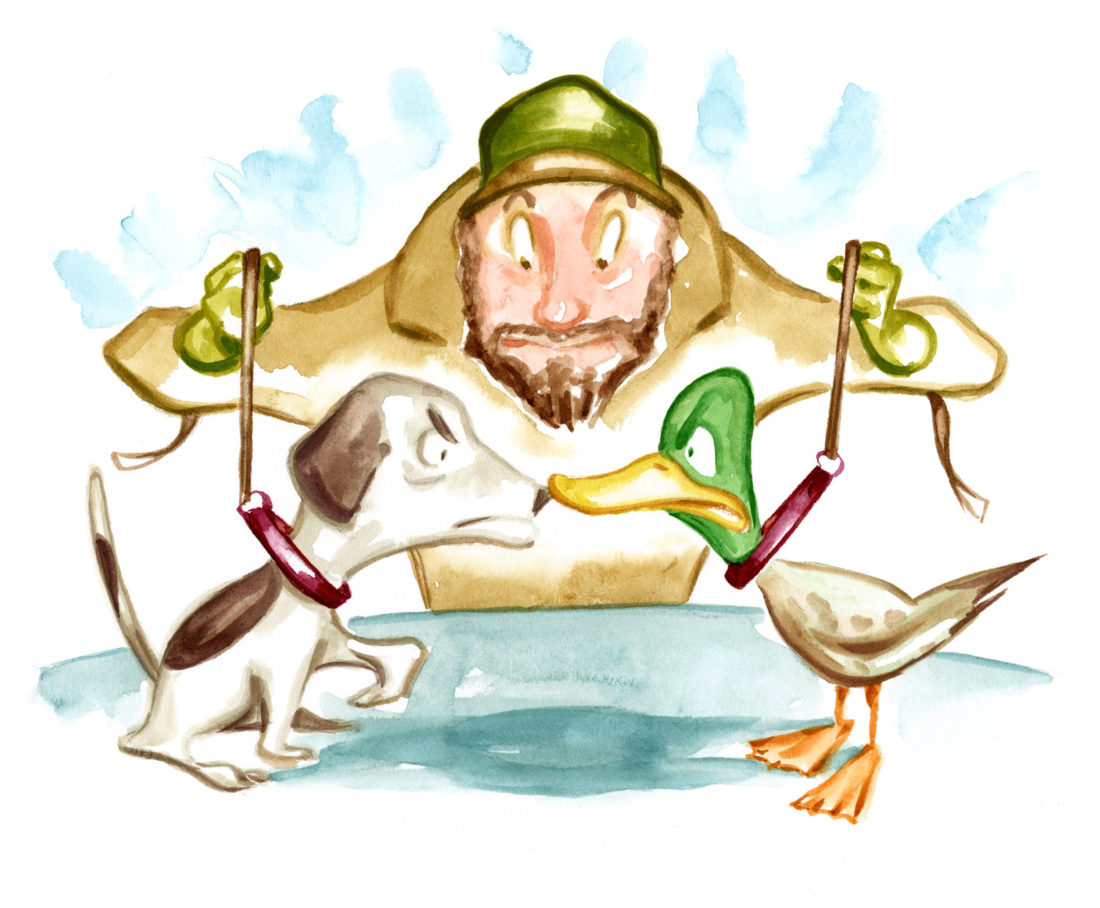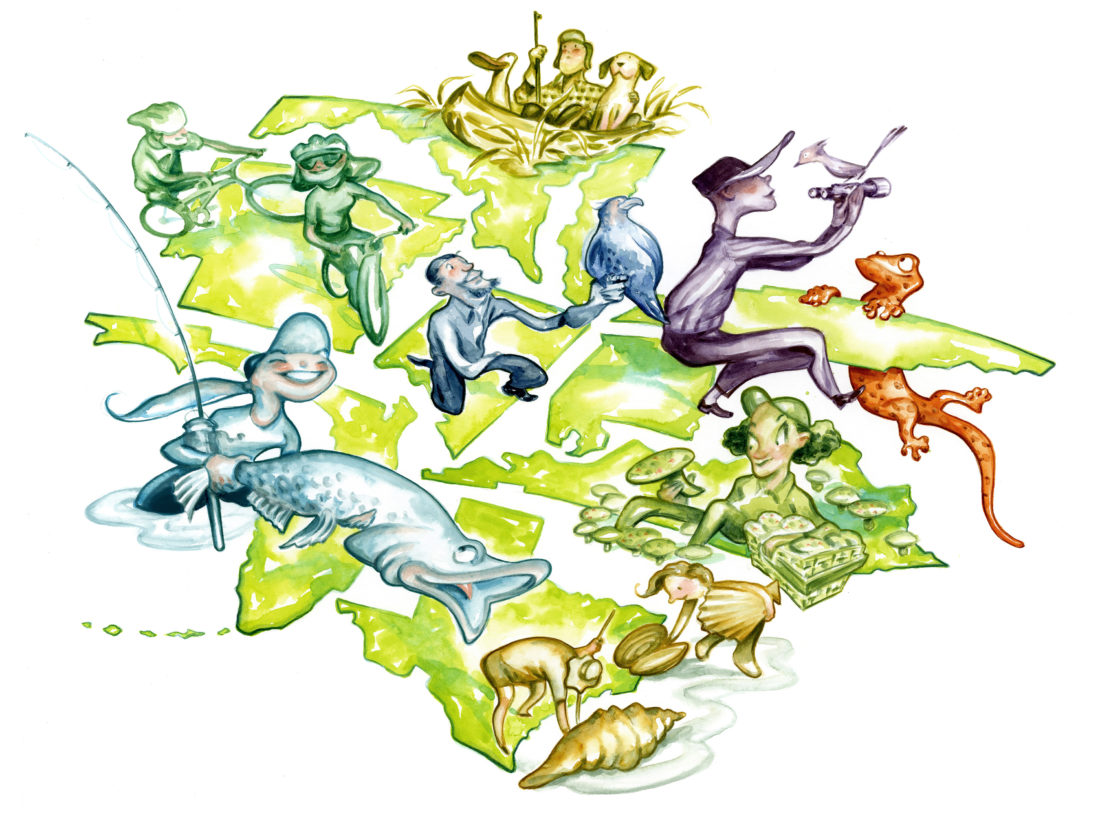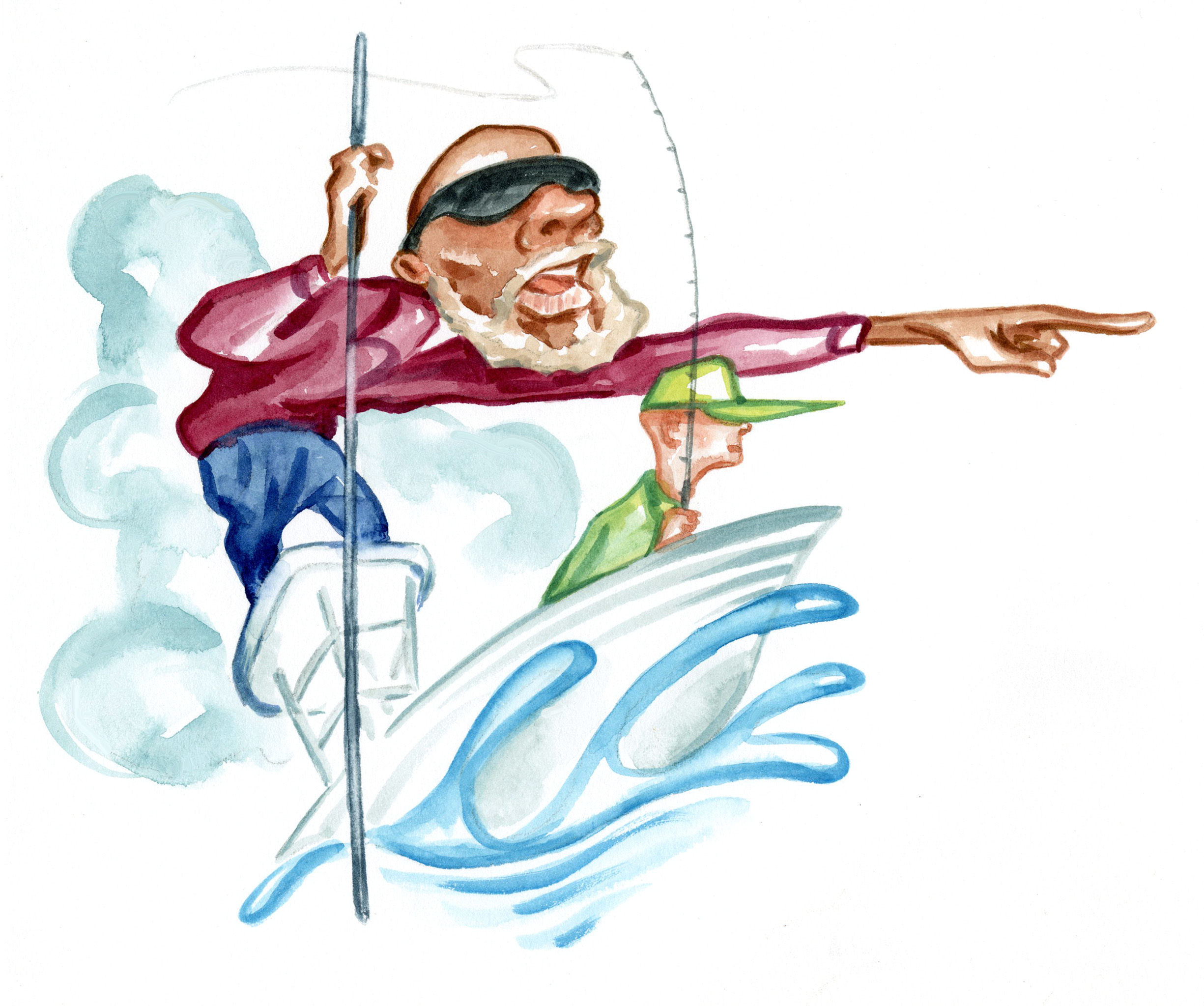Alabama: Birding
Forty-five minutes northwest of Selma, Christopher Joe and his father, Cornelius, operate Connecting with Birds and Nature Tours on their two-hundred-acre working cattle farm in Newbern. “It’s a multi-habitat piece of land,” the younger Joe explains of the farm’s prairie, creeks, hay fields, and deep hardwood forest. “Over in the wetlands we see white ibis, wood storks, herons, and egrets. We see bald eagles every tour.” Visitors hike, cycle, and camp, but the site’s most popular activity is bird-watching. The family partners with Alabama Audubon and can accommodate private tours and small groups as well as large gatherings for up to 140 people. They’re as comfortable showing beginners how to use binoculars as they are guiding seasoned bird-watchers to find Mississippi kites, petite Southern birds of prey. The Joes also believe birding is for everyone regardless of mobility, and they offer accessible tours via an eighteen-foot spring-loaded trailer that they can move around the property to scout out swallowtails, pileated woodpeckers, and vibrant indigo buntings. www.connectingwithbirdsandnaturetours.com/

Arkansas: Cycling
Some 85 percent of county roads remain unpaved in the Natural State, and for cyclists, that means miles and miles of heaven, bliss, and Valhalla all bundled into one giant scoop of Ozarks rocky road. “It’s so big and so untapped,” says Danny Collins, an Ozarks native who founded 37 North Expeditions with his wife, Cristina Bustamante, after moonlighting as an expedition manager for National Geographic at a lodge in South America. But while the roads looping around Fayetteville and Bentonville might be rugged, the guarantee of support vans bringing up the rear of a cycling pack, catered creekside lunches, and stop-offs at pubs, including Ivory Bill Brewing Co. and Tall Pines Distillery, places 37 North’s guided rides decidedly in the beaten-path camp. As Collins says, they want the focus to be on everything save the details so the riders can “get sweaty, get connected, get happy.” www.37northexpeditions.com
Florida: Fishing
Based on Marco Island, Andy Lee of Grassroots Guiding can be as goal oriented as any hard-core guide. You want to target hundred-pound migrating tarpon? During the spring migration, he chases them a hundred days in a row. After double-digit snook on the fly? He’s game. But one of his favorite ways to spend a day in the Everglades and Ten Thousand Islands is to let the tides and the weather and the fish in this vast marine backcountry tell you what they have in mind. He’ll run his smaller Hell’s Bay skiff, a fourteen-foot, eight-inch Devil Ray, into a place he calls “the way, way back,” and be open to whatever the mangrove wilderness has to offer on a given day. “When the way, way back is happening, it’s something to be seen,” Lee says. “You get back into some tiny pond and you might catch a largemouth, you might catch a baby tarpon, or you might catch a snook. It has that virgin, unpressured feel. It’s just a giant playground where you can explore and try new things.” www.evergladesflyfishingguides.com
Georgia: Fossil Hunting
Captains David and Rene Heidt grew up on Tybee and Little Tybee Islands, where visitors and residents lounge on the sandy barrier-island beaches. The Heidts founded Sundial Tours to provide a naturalist perspective on the area, including trips to nearby Wassaw Island and Daufuskie Island; dolphin tours at twilight; and guided hunts for ancient fossils. The Heidts depart from Tybee’s Back River Beach into the rolling brown and green marsh, traveling up the Savannah River where white egrets perch and wrens call out. “The fossils settle above the Georgia clay,” Rene says of the piles of earth and clay dredged out over centuries from the river. And that’s where you’ll look—along muddy banks to discover alligator teeth, ancient fish vertebrae, stingray barbs, and maybe the fossilized tooth of a megalodon. “The megalodon shark,” Rene explains, “could fit a T. rex head in its mouth. It was like a school bus with teeth.” www.sundialcharters.com

Kentucky: Foraging
In the spring, George Barnett can lead you to morels and ramps hidden in shaded soil. Come summer, he’ll steer you right to blueberries along eastern Kentucky’s sandy ridges, and pawpaws, spicebush, and elderberries just off forested trails. During his autumn foraging workshops, you can follow him to seven-pound lion’s mane mushrooms that grow from decaying trees. “Ecology and different ecosystems around Kentucky create so much diversity,” says Barnett, who helms the Hungry Forager and leads group expeditions and private field trips through the parks and woods around his hometown of Louisville, as well as treks to Daniel Boone National Forest and the Cumberland Gap region. “Autumn brings pleasant weather with enough moisture hanging around for wild mushrooms, bitter cress, certain garlics, and anise root that tastes like licorice,” he says. Barnett teaches students how to process gallons of acorns into flour and infuse juniper berries into gin, emphasizing how connected we all are to our food and the ground that produces it. “I didn’t have a sturdy connection to this land,” he says, “until I dug my feet in.” www.thehungryforager.com
Louisiana: Fishing
As a native son of the Sportsman’s Paradise, Captain Brooks Levy is aptly suited for his current occupation. He has been fishing since childhood and has now turned that passion into his Offishial Charters, a thriving guide service. Operating out of Rigolets Marina in Slidell, Levy specializes in light-tackle, inshore pursuit of redfish, spotted sea trout, and flounder in Lakes Pontchartrain and Borgne, and nearby Biloxi Marsh. Family charters (four anglers) are a favorite aboard his Avenger AV-26 bay boat, and autumn is Levy’s favorite season. That’s when big trout are bulking up in anticipation of leaner months ahead, and reds rarely disappoint. “Southeast Louisiana’s coastal lakes and marshes are full of life, and it’s the perfect time to go,” he says. Levy also puts clients on the biggest flounder in the fall—up to six pounds—using Carolina or drop shot rigs with live shrimp or tossing Matrix Shad and D.O.A. shrimp lures. www.offishialcharters.com

Maryland: Hunting
Captain Josh Bourne of Wingman Guide Service is a U.S. Coast Guard–licensed Chesapeake Bay waterman and son of the same. Bourne speaks of the bay as if it were another family member, and given how much of his life revolves around the bay and its moods, perhaps it is. Summer finds him in the tower atop a forty-foot Chesapeake Bay deadrise boat scanning for hard-fighting cobia by day or big bull drum by night. When the weather turns cold and windy, he shifts to a twenty-three-foot Forrester Boatworks duck boat of his own design. Smiling through an ice-rimmed beard, Bourne safely and comfortably leads duck hunters to blinds through water conditions that can feel like those of open ocean. Bourne’s obvious deep pleasure in sharing the Chesapeake’s “rich waterfowling history, combined with prime habitat, and opportunities for numerous species” with hunters and anglers is almost as satisfying as the adventures to be had. www.facebook.com/WingmanGuideService
Mississippi: Kayaking
During his childhood in Jackson, Christopher Lockhart spent most of his free time outside, fishing and gardening with his dad. When he returned to the city after college, he began kayaking on the Pearl River and bought an extra boat to share with friends. One communal vessel soon became a fleet, and Lockhart’s hobby became an outfit called Capital City Kayak Adventures. He operates by reservation, showing off his hometown by water on leisurely beginner paddles and on half-day excursions when he takes guests out to explore islands in the Pearl River and a natural oxbow called Crystal Lake. “It’s mostly sand at the bottom, and it creates nice little beaches,” Lockhart says. “You can pull up to an island and have lunch while watching the wildlife swim by.” During his autumn tours, Lockhart regularly spots birds migrating to their winter homes—great egrets, great blue herons, and, if he’s lucky, roseate spoonbills. www.capitalcitykayaks.com
North Carolina: Fishing
You might not see them in wing tips and pumps, but in just about every other way this is the power couple of Southern saltwater guiding: Between them, Brian Horsley and Sarah Gardner of Outer Banks Fly Fishing have fifty-four years of serious international experience, on both fly and conventional tackle. And over twenty-two years as Mr. and Mrs., splitting time between North Carolina’s Harkers Island and Nags Head, the pair have hosted trips from Alaska to Baja California, and from the Amazon to Guatemala. But for most of the year, they stalk the northern and southern Outer Banks. In spring and summer, they work the waters around Oregon Inlet, chasing redfish, speckled trout, blues, and more. In the fall, around Harkers Island, much of life centers on the green-backed devil fish of the Cape Lookout region: false albacore on the fly. Two boats and two captains and a half century of experience is a hard-to-beat recipe for success. “We’re on the phone or radio all day long,” Horsley says. “We fish a lot of water, and having a couple of trusted guides to communicate with is huge. We look at things differently—she’s more of a teacher, while I can be a bit of a hard-ass—but it’s so much fun for us to keep each other sharp.” www.obxflyfishing.com

South Carolina: Fishing
When it comes to saltwater fishing, Charleston is your proverbial oyster, but the number of guides you can choose from is dizzying. Some are straight up fish hounds. Others are family oriented. Captain Jim Hutson of Explore More Inshore Charters successfully marries both of these styles. The native Charlestonian, who has been knee-deep in pluff mud since he could walk, started guiding at twenty-one and has built a reputation for putting clients on fish while also taking the time to show off his beautiful and beloved corner of the Lowcountry. Catch redfish and trout early, or venture near shore for cobia, spadefish, or Spanish mackerel and then explore a boneyard beach while having lunch—and possibly enjoy an oyster on the half shell plucked from a tidal creek. www.exploremorewater.com
Tennessee: Caving
“Darkness doesn’t have to be scary,” says John Benson, outdoor program director at Sewanee. Tennessee is known to cavers worldwide as part of the TAG (Tennessee, Alabama, and Georgia) area, where water has carved out some fifteen thousand limestone caves—more than ten thousand of them in Tennessee. Benson introduces cavers to subterranean residents—bats and spiders aplenty, a bright orange spotted cave salamander, and deeper, more ancient dwellers like blind cave crayfish and the endangered Tennessee cave salamander, both pigmentless after millions of years underground. Benson’s favorite beginner spots include Buggytop, with an eighty-foot limestone amphitheater in South Cumberland State Park, and the maze-like Catacomb cave near Kimball. For the experienced, he favors McBrides cave on the Tennessee-Alabama border, a vertical stunner with nine drops inside a mountain. A trip highlight for Benson is the moment of reemergence: “Everyone is always amazed by how green it is—that sensory spike—when you reenter the above-ground world.” www.sewanee.edu
Texas: Shelling
Just outside Corpus Christi, Padre Island National Seashore encompasses more than 130,000 acres of uninhabited federally protected seashore. “Because it’s so treacherous, the Spanish called our section of the coastline el codo del diablo, which translates to ‘the devil’s elbow,’” says Captain Colin Davis of Padre Island Expeditions, who has led fishing, birding, camping, and shelling adventures on the national seashore for sixteen years. “Unstable weather, combined with the loop current in the Gulf, brings us things from as far away as Africa or even Japan.” Those things that wash ashore include a plethora of seashells, which hit their peak abundance when cold weather rolls in. “The shell assemblage changes at the middle of the national seashore,” Davis says. “There is a point where the currents converge and wash up a smorgasbord.” On Davis’s all-day hunts, visitors traverse the wide, unpeopled beach by truck and on foot to fill buckets with horse conchs, angel wings, shark eyes, lightning whelks, eastern murex, pen shells, coquinas, and Southern quahogs. www.padreislandexpeditions.com
Virginia: Fishing
Muskie fishing is, well, different. “It requires a certain mindset,” says Matt Miles, a Lynchburg-based guide and commercial fly designer who has been at it for twenty-three years. “People have to know what they’re getting into.” Which is what, exactly? Long days of casting big flies (up to fourteen inches in length) from Miles’s drift or jet boat, making sure to hit every sunken tree, ledge, or deep hole on the James, New, or Shenandoah River. Notoriously picky, muskies are known as “the fish of ten thousand casts,” which is an exaggeration, but maybe not by much. The reward, though, is thoroughly worth it—the breathtaking ambush of the fly, the hand-to-hand combat of the fight, and, just maybe, the landing of a true river monster (fish of up to thirty-five pounds). The challenging combo of scarcity and size is the point—and the fun. www.mattmilesflyfishing.com

Washington, D.C.: Raptors
“People tell me all the time that they’ve never seen a Black man with a hawk before,” says Rodney Stotts, who was so inspired when he held his first raptor at age twenty-five that he became a licensed master falconer, one of the few African Americans in the country to have earned that title. Stotts has since shared his passion for raptors, and his belief in their healing power, with thousands of D.C. at-risk youth, inspiring the next generation of falconers. “Sometimes when I get a glove on people and let them hold a bird, they burst into tears; it’s that kind of experience,” Stotts says. This fall, he’ll be exercising his five birds before winter hunting, putting on demonstrations through his business, Rodney’s Raptors, and opening a bird sanctuary in Virginia called Dippy’s Dream (named after his mother). You might catch an impromptu demo in the capital, where Stotts visits a few times a week. “I walk down the street, blow a whistle, raise my arm, and that bird will fly behind me and come land on my glove,” he says. “Traffic just stops.” www.rodneysraptors.webs.com
West Virginia: Fishing
Jacob Ott was the Director of Outdoor Pursuits at the Greenbrier resort in White Sulphur Springs for a dozen years before he started his own guiding business in 2018. He can pretty much guide you to anything with fins (or feathers), but his specialties are trout and smallmouth bass, which he chases on a variety of rivers. His trips for the former take place in the beautiful Greenbrier River valley; Second Creek, with its excellent hatches and abundance of healthy trout, is one of his favorites. The smallmouth action starts on the Greenbrier and New Rivers in the spring, when Ott hunts the biggest bronzebacks of the year. Later in the year, the smallie play on those rivers is unbeatable fun, with loads of eager fish coming to popping bugs on top and streamers in the riffles. “The magic of this area,” Ott says, “is the sum of all of its different parts.” www.ottersguide.com
—Monte Burke, David DiBenedetto, Latria Graham, Jordan P. Hickey, Dave Lear, Lindsey Liles, T. Edward Nickens, Russell Worth Parker, Caroline Sanders, and Amanda Eyre Ward









